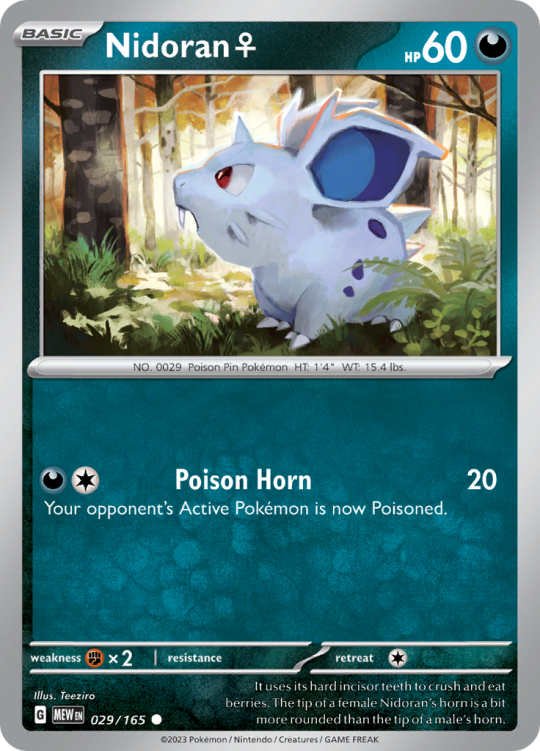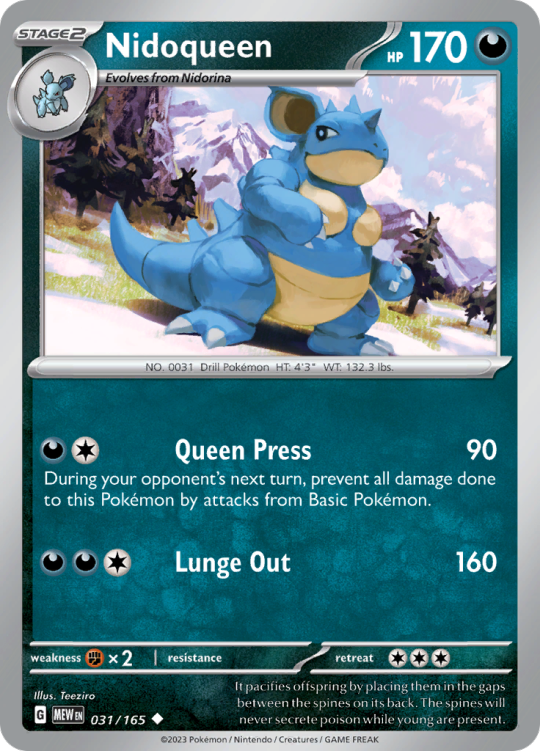#Nidoran-F
Explore tagged Tumblr posts
Text
Best Underdog Gen 1 Blue Pokemon
Round 1 - Match 6
Our Contestants:


This poll is part of an event that allows the early eliminees from the main tournament have more time in the spotlight!
#uptunderdogtournament#pokemon#polls#best underdog gen 1 blue pokemon#nidoran♀#nidorina#nidoranf#nidoran-f
40 notes
·
View notes
Text
Pokemon: Shiny vs. Default, 0029-0031
Man, remember when Pokemon having genders and sexual dimorphism made them count as two separate species? Man, Gen I was wild.
Anyway, today we’re covering Nidoran-F and its evolutions, one of those Pokemon that’s great for pretty much any team and a welcome addition to any run.
First up, Nidoran.

Okay, I love the Nidoran line’s shinies, for the most part, because they (mostly) switch colours between the two genders/lines. These are auto-generated shinies, so it’s pretty impressive that they managed to land on these colours. While I generally prefer that Nidoran-F is blue and Nidoran-M is pink (gotta break those gender roles), the shiny forms switching that up is such a good concept that I’m going to give the shiny the nod here. I prefer the originals, but this is such a good switch that I have to give it points.
Now for Nidorina.

Second verse, same as first, honestly. Helps that these pink shades are pretty good. I will say that I’m not wild about the green ears, but nonetheless, still giving the shiny points.
Finally, Nidoqueen.

God fucking damnit, we were so close. So close! All they had to do was make her Nidoking colours and instead we end up with one of the worst green shades and one of the worst pink shades, combined into this thing.
Default wins.
Default: 32
Shiny: 12
Draw: 3
5 notes
·
View notes
Text
Pokemon Card of the Day #2779: Giovanni’s Nidoran-F (Gym Challenge)

Giovanni’s Nidoran-F was a Pokemon you wouldn’t expect to be good. It did, however, have some decent power for its cheap attacks, and if anything around had a Grass Weakness it might have some potential. Sadly, peak Grass Weakness came after Double Colorless Energy rotated out. The other side of that was that there was a point that there was one dominant deck, and with that deck having the right Weakness people were going to try anything to deal with it. That included Giovanni’s Nidoran-F.
50 HP was nothing to write home about, especially on a Pokemon with an attack that had recoil. One attack lowered the HP to 30 which was enough to have it fall to almost anything. It did mean that the Psychic Weakness meant little, and the Retreat Cost was just 1 but Giovanni’s Nidoran-F would struggle to survive long enough to take advantage of it.
Horn Thrust needed a Grass Energy and had a coin flip. 20 damage was done with a heads flip and nothing was done on tails. This wasn’t the attack you’d normally be going for.
Double-Edge was surprisingly decent for 2 Colorless Energy. 30 damage was like a Scyther Slash for less Energy, but there was 20 recoil which made it even easier for a revenge KO. This attack was mostly worth something against Pokemon with a Grass Weakness. If trying it in Base-Gym or Prop 15/3, you had the benefit of Double Colorless Energy and PlusPower, letting you target the occasional Aerodactyl or Dark Gyarados.
In reality, this saw the most play in the early stages of the Rocket-On format. The issue here was that it took 2 turns to charge up, which made it telegraphed. Some Typhlosion/Blaine’s Arcanine decks still used this since it could KO a Totodile, with the goal being to get it out quickly before things started evolving. It was still doing half a Feraligatr’s health, at least.
GIovanni’s Nidoran-F had a short-lived niche as a way to try to give Fire decks a way to take down Totodile before they evolved. Modern players of the format don’t really use it due to the full Rocket-On format being more diverse (especially with the Slowking errata). It really only shined at a time with an extremely centralized game, and even then some tried other Pokemon like Erika’s Bellsprout. It’s at least interesting that a Pokemon like Nidoran-F could even get into some decks for a short period of time, especially since it was done as an attacker.
15 notes
·
View notes
Text

#0029 - #0031 Nidoran, Nidorina, Nidoqueen
If you like my work please consider commissioning me! Also, consider supporting me on Patreon or buying me a Ko-fi!
104 notes
·
View notes
Text




More LS style Pokemon and one Neopet for good measure.
38 notes
·
View notes
Text



Nidoran♀ MEW 029, Nidorina MEW 030, and Nidoqueen MEW 031 by Teeziro from Scarlet & Violet—151
#pokemon#pokemon tcg#pokemon cards#pokemon card game#pokemon sv#sv 151#MEW#Nidoran f#Nidoran female#nidorina#nidoqueen#teeziro#dark type#uncommon#common#pokemon scarlet and violet
56 notes
·
View notes
Text




Some illustrations from my updates-whenever webstory, Safari Zoned.
8 notes
·
View notes
Photo

Pinkumon 25 to 34! - Pikachu Raichu - Sandshrew Sandslash - Nidoran F, Nidorina, Nidoqueen - Nidoran M, Nidorino, Nidoking Pinkumon is my series where I redraw or redesign pokemon in my personal favorite aesthetics and colors!
Posted using PostyBirb
#pinkumon#pokemon#pokemon variants#pikachu#raichu#nidoran f#nidorina#nidoqueen#nidoran m#nidorino#nidoking
100 notes
·
View notes
Text
Nidoran Female

8 notes
·
View notes
Text

7 notes
·
View notes
Text









lesbian pokémon icons (incl. nidoran, nidorina, and primarina) for anon! ❤️ like/rb if used?
#lesbian icons#pokemon#pokemon icons#pride icons#nidorina#primarina#nidoran f#glaceon#froslass#brionne#nidoqueen#alolan ninetales#azurill#icons#requested#pkmnpride
85 notes
·
View notes
Text
#029. Nidoran F

Its highly toxic barbs are thought to have developed as protection for this small-bodied Pokémon. When enraged, it releases a horrible toxin from its horn.
Colour and symbol charts can be found here.

A note on colours: in my experience, floss looks different irl than in online pattern makers. If you think a different colour will work better, go with your gut!
13 notes
·
View notes
Text


029 Nidoran F - Daily Drawing
#nidoran#nidoran f#pokemon#pokeart#pokemon fanart#gen 1 pokemon#generation 1 pokemon#traditional art#nidoran female
3 notes
·
View notes
Text
Headcanon: Shiny nidorans are trans nidorans
So like. The normal colored female evolutionary line for nidoran is blue right. And the male is purple. But the shines are swapped. The males are blue and the females are purple (up until nidoqueen, who’s green)
So shiny nidoran females are transfem, retaining their old color but changing in looks, and shiny nidoran males are transmasc, doing the same.
The hormone change is what makes nidoqueen end up green.

As such
ID: An image outlaying the comparison of the regular colors vs the shiny colors of the male and female nidoran evolutionary line. End ID.
#pokemon#pkmn#poison type#ground type#nidoran#nidorina#nidorino#nidoking#nidoqueen#shiny pokemon#nidoran male#nidoran f#trans#transgender#lgbt#lgbtq#lgbtqia#queer#queer meme#queer memes#trans memes#headcanon#headcanons
51 notes
·
View notes
Text

new silly! still a wip but i like them a lot so far :]
#art#digital art#doodle#artist#oc#pokemon#pokemon art#pokemon oc#pokemon mystery dungeon#rinnies ocs#pokemon mystery dungeon explorers of sky#pokemon fusion oc#pokemon fusion#nidoran#nidoran f#nidoran male#nidorina#nidorino#nidoking#nidoqueen#galarian ponyta#ponyta#galarian rapidash#rapidash#artists#artwork#artists on tumblr#artist on tumblr#digital artist#digital drawing
15 notes
·
View notes
Text
Anipoke Reference List - Nidoran Female


#nidoran f#nidoran#nidoran female#art reference#pokemon#drawing reference#anipoke reference list#anime reference art
4 notes
·
View notes